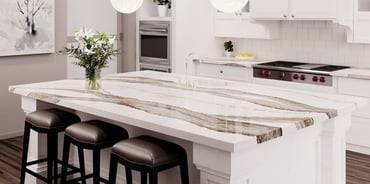Over the last few years, being environmentally conscious has become a priority for many people, including homeowners. Remodeling a kitchen can create a ton of landfill waste, depending on some very crucial decisions the customer makes along the way.
If you are looking to remodel your kitchen without leaving such a large carbon footprint, we’ve got some tips that’ll definitely do the trick. To find out what you can do to remodel your kitchen in an environmentally friendly way, keep reading!
Cabinet Refacing
Cabinet refacing is a great way to significantly reduce the amount of trash and waste that will go to the landfill. This process saves wood by only using new material for the doors, drawer fronts exterior cabinet application, but leaving the original cabinet boxes intact and giving them a gorgeous facelift. Saving wood of course translates into fewer trees being cut down, which in turn, means saving the habitat of thousands of woodland creatures.
Once the refacing process is complete, there is also less trash produced from the project. Because the volume of materials being taken from the completed project is much less than that of a full cabinet replacement, less garbage goes into the landfills. In fact, the amount of landfill waste of refacing is 75% less when compared to a full cabinet replacement.
Man-Made Materials
Another way to reduce the impact of kitchen remodeling on the environment is to choose man-made materials. A perfect example of this is choosing an engineered quartz countertop over granite. Here’s why: quartz is proven to be more durable, its patterns are reliably consistent, and quartz is non-porous, making it moisture and bacteria resistant. What’s better... these benefits only add to the material’s lack of impact on the environment in comparison to its stone counterparts.
Let’s look at it this way: natural stone countertops like granite and marble are unpredictable and inconsistent, since they are extracted from the earth. Only mother nature knows exactly what it will look like. In order to get the actual pattern you want, you may need to see many different slabs. To cut and polish each slab, hundreds of gallons of water are used to complete each phase of this process, not to mention the electrical power needed to operate the equipment. The manufacturing process for stone is energy intensive. The extraction, cutting and polishing processes to prepare for installation in the home all cause a large burden of water and air pollution.
 Man-made countertops can be consistently cut into the pattern and color of the specific style, reducing the power and water it takes to create the slabs necessary for a project. We’re not saying that quartz has no impact on the environment, because let’s be honest, manufacturing these products still takes electricity, water, and other resources. Some quartz manufacturers, like Cambria, even use recycled materials to create their products.
Man-made countertops can be consistently cut into the pattern and color of the specific style, reducing the power and water it takes to create the slabs necessary for a project. We’re not saying that quartz has no impact on the environment, because let’s be honest, manufacturing these products still takes electricity, water, and other resources. Some quartz manufacturers, like Cambria, even use recycled materials to create their products.
If you are looking for a lesser carbon footprint, engineered quartz surfaces are hands down the clear choice. Not only is it better for the environment, but it is much less maintenance far into the future, meaning less money out of your pocket for upkeep.
Water and Energy Efficient Fixtures
If you’ve ever been to a big box store, you’ve seen aisles that are home to dozens of displays of light fixtures, faucets, etc. But how do you know if these items are going to make your kitchen a more friendly place for mother nature and all that she has created? There are a few things to look out for when selecting these products.
Sink faucets each come with their own unique features. Specifically, many of them come with features to reduce the amount of water used. Some of them reduce the water pressure of the faucet, and some have motion sensors so that the water only runs when you command it to and does not run continuously, wasting water.
When it comes to lighting, fixtures aren’t necessarily the issue, but are an easy place to save some energy in your kitchen and even throughout your home. Using LED bulbs significantly reduces greenhouse gas emissions, in some cases by 75-80% compared to regular light bulbs. While the typical light fixture itself may not have a positive impact on the environment, selecting a secondhand fixture or one made of recycled materials is a small way to contribute to the reduction of environmental impact.
Appliances with a Purpose 
Energy efficient appliances are hard to ignore these days. Almost all appliances are made with an Energy Star label. The price with or without an Energy Star label does not differ much, if at all. So how does a product receive such a label? “The EPA gives products the ENERGY STAR label when they meet the following strict energy efficiency specifications:
- Product categories must contribute significant energy savings nationwide.
- Certified products must deliver the features and performance demanded by consumers, in addition to increased energy efficiency.
- If the certified product costs more than a conventional, less-efficient counterpart, purchasers will recover their investment in increased energy efficiency through utility bill savings, within a reasonable period of time.
- Energy efficiency can be achieved through broadly available, non-proprietary technologies offered by more than one manufacturer.
- Product energy consumption and performance can be measured and verified with testing.
- Labeling would effectively differentiate products and be visible for purchasers” (Black Hills Energy).
Not only do these products have a more positive impact on the environment compared to ones without, but they also keep money in the homeowner’s pocket by reducing the electricity needed to power them. They also reduce the emissions caused by power plants; the less energy you use, the less the power plant produces.
Phantom Power
This may come as a surprise to some, but leaving your small countertop appliances plugged in is still using electricity. This is called “phantom power”, and it’s an easy fix. Not only does this help to slightly reduce an electricity bill, but it also helps to reduce your carbon footprint.
Some things you might want to unplug if you are not using them are coffee makers, blenders, air fryers, mixers, and toasters. If these items are plugged in, they are using electricity, even if they are not turned on. This is also true for phone and computer chargers. Did you ever notice that when you remove your plug from your laptop, it’s light is still on? To put this into perspective, it is estimated that the United States spends around $19 billion per year as a whole in unused electricity.
Small Acts, Big Impact
All these adjustments may seem small, and you may be asking “Are these little things really going to make that much of a difference?”
Remember this: one household following these tips may not have much of an impact on helping to reduce our carbon footprint, but if more and more people take even just a few of these pieces of advice and apply them in their home, the results can change the world around us for the better, forever.
To learn more about how you can remodel your kitchen in a way that is more ecological, call Kitchen Magic at (866) 525-0012 for a free Design Consultation.









